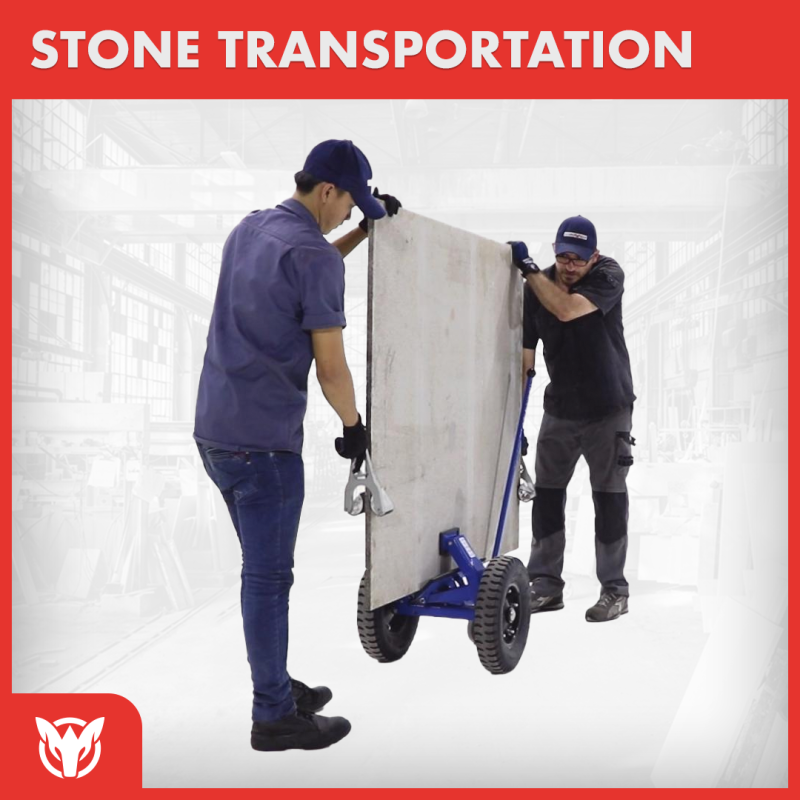



In construction and fabrication, stone transportation is a fundamental yet often underestimated aspect of material management. Whether it’s granite, marble, porcelain, or engineered stone, these materials are not only heavy but also fragile, requiring careful handling to prevent breakage and maintain efficiency.
Unlike other construction materials, stone slabs cannot be stacked haphazardly or moved without consideration. The challenges are particularly pronounced in tight workspaces where maneuverability is limited or on uneven job sites where stability is a concern. Without the right transport strategies, delays, material losses, and safety risks quickly become costly without the right transport strategies.
How can the industry improve stone transport efficiency while reducing damage and labor strain? The answer lies in specialized equipment, careful logistics planning, and a better understanding of transport physics.

Stone handling involves more than just moving slabs from one place to another. It requires balancing stability, accessibility, and protection to ensure that materials arrive at their destination intact and ready for use. Here are some key challenges in stone transportation:
Natural and engineered stones are both dense and brittle. A single misstep—whether a sudden jolt, uneven pressure, or improper stacking—can lead to cracks or chipping, rendering expensive slabs useless.
Construction sites and fabrication workshops often have narrow aisles, crowded storage areas, or confined workspaces, making it difficult to transport large slabs safely.
Stone surfaces are prone to scratches and stress fractures when placed on hard or uneven surfaces. Improper loading and unloading can also cause slabs to develop hidden micro-cracks, which later expand under pressure.
Lifting or manually transporting heavy stone slabs increases the risk of strain injuries and accidents. Without ergonomic handling solutions, workers face higher fatigue levels and productivity losses.
Construction environments often include gravel, dirt, and uneven ground, making smooth stone transport more challenging. Standard wheeled transport solutions may struggle with stability, leading to tipping hazards and material loss.
Advancements in stone handling technology have led to better transport tools that address these challenges. Investing in the right equipment not only reduces material waste but also improves workflow efficiency and workplace safety.
Self-locking trolleys have become a game-changer in stones transportation, particularly in tight workspaces. Their automatic clamping mechanism secures slabs instantly, eliminating the need for manual adjustments and reducing handling risks.
Best for: Workshops, narrow spaces, and general slab transportation.
Key benefits: Instant gripping, improved maneuverability, and reduced risk of slab tipping.
Traditional horizontal slab stacking takes up excessive space and increases the risk of damage. A-frame carts provide a vertical transport solution, keeping slabs upright and stable while maximizing storage efficiency.
Best for: Warehouses, delivery vehicles, and slab storage.
Key benefits: Reduced storage footprint, easy loading/unloading, and better weight distribution.
For larger-scale stone transportation, slab lifters and clamps used with cranes or forklifts offer precise control and reduced labor strain. These tools allow slabs to be lifted, rotated, and positioned without excessive manual handling.
Best for: Large stone slabs, factory operations, and crane-assisted installations.
Key benefits: Precision lifting, minimized manual effort, and reduced material stress.
While equipment plays a major role, how materials are handled and moved also determines success in stone transportation.
An imbalanced slab is more likely to tip, crack, or strain transport equipment excessively. Ensuring even weight distribution across the transport device prevents unnecessary stress on the stone and increases handling safety.
Obstructed or unplanned transport routes lead to bottlenecks, accidents, and wasted time. Defining clear, designated transport paths improves overall workflow efficiency.
Using rubber-padded supports or shock-absorbing wheels minimizes the effects of sudden jolts and vibrations, reducing the likelihood of internal cracks in the stone.
Rather than moving all slabs at once, scheduling staggered deliveries or staggered internal transport prevents congestion and reduces the likelihood of handling errors.
No transport tool is effective without proper worker training. Educating teams on proper lifting techniques, equipment usage, and safety protocols ensures smoother operations.
Beyond moving stone slabs on-site, efficient delivery logistics also contribute to material safety and construction speed.
Technology continues to shape the way stone transport is managed:
The transportation of stone materials is not just about moving slabs from point A to point B—it’s about doing so efficiently, safely, and with minimal material loss. Whether in tight workspaces, rough terrains, or high-volume construction sites, using the right transport tools and methods makes a significant difference.
By integrating self-locking trolleys, A-frame carts, slab lifters, pneumatic wheels, and safety-first transport strategies, businesses can improve productivity, minimize waste, and enhance overall workflow in stone transportation.
As the industry continues to evolve, embracing smarter transport solutions and emerging technologies will be key to maintaining efficiency and sustainability in stone handling and construction logistics.
Sign up to receive the latest info on new Aardwolf products, special offers and more.
By signing up you agree to receive emails from Aardwolf with news, special offers, promotions and other information. You can unsubscribe at any time.